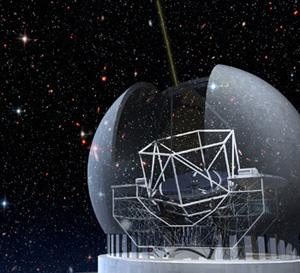A leading astronomer at UC Santa Cruz hailed the selection of Mauna Kea in Hawaii as the site for construction of the Thirty-Meter Telescope (TMT), which will be the largest and most advanced telescope ever built.
"This is exciting, because it means we can move into the next phase of the project," said Michael Bolte, professor of astronomy and astrophysics at UCSC and director of University of California Observatories. UCSC is a managing partner of the W. M. Keck Observatory on Mauna Kea, which houses the world's largest optical and infrared telescopes, the twin 10-meter Keck I and Keck II Telescopes.
"The TMT will be a great discovery machine," added Bolte, who has been active in the planning and design of the TMT and is on the TMT Board of Directors. "I'm sure we'll find things nobody ever thought existed in the universe."
With the TMT, astronomers will be able to analyze the light from the first stars born after the Big Bang, directly observe the formation and evolution of galaxies, see planets around nearby stars, and make observations that test fundamental laws of physics. Jerry Nelson, professor of astronomy at UCSC, is the TMT project scientist.
Building the telescope on Mauna Kea--which is home to many of the world's leading observatories and more than a dozen telescopes--will foster scientific collaboration, said Bolte. "Because the TMT partners operate existing observatories at Mauna Kea, it will be possible to integrate our planning much better in terms of scientific programs, the instruments we build, and possibly even sharing key technical staff," he said.
The TMT is the first of a new generation of giant, ground-based telescopes that will build on the success of the Keck telescopes. The TMT will use new technology to correct for the blurring effect of Earth's atmosphere, enabling the TMT to study the universe as clearly as if it were in space. The core technology of the TMT will be a 30-meter primary mirror composed of 492 segments that span 30 meters in total, three times the effective diameter of the current largest telescopes. All of the segments will be under precision computer control so that they work together as a single mirror, giving the TMT nine times the collecting area of today's largest optical telescopes. The telescope is slated to begin operation in 2018.
The TMT will utilize adaptive optics technology pioneered at UC's Lick Observatory. The UCO Technical Labs at UCSC and UCLA have been selected to build two major instruments for the TMT, according to Bolte.
"Using adaptive optics, the TMT will produce images much sharper even than have been produced by the Hubble Space Telescope," he said. "It will be a revolutionary tool for looking at the distant universe, when the first stars and galaxies were forming. This will be a huge jump forward."
After years of consideration, the TMT site-selection committee last year narrowed down their choices to Mauna Kea and Cerro Armazones in Chile. The board of directors of the TMT Observatory Corporation cited Mauna Kea's atmospheric conditions, low average temperatures, very low humidity, as well as opportunities for collaboration, in announcing their decision. The peak of Mauna Kea, a dormant volcano on the island of Hawaii, rises 13,803 feet above sea level.
Before construction can begin, the TMT must complete an environmental impact statement and gain approval for a Conservation District Use Permit (CDUP) from the Hawaiian Department of Land and Natural Resources.
The TMT is a collaboration of the California Institute of Technology, the University of California, the Association of Universities for Research in Astronomy (AURA), Inc., and the Association of Canadian Universities for Research in Astronomy (ACURA), with significant work being done by industry and by university teams studying instrument designs. The project office is in Pasadena, California. The Gordon and Betty Moore Foundation contributed $50 million to the design development phase of the project and has pledged an additional $200 million toward construction.
#####
Note to journalists: Bolte can be reached at bolte@ucolick.org.



